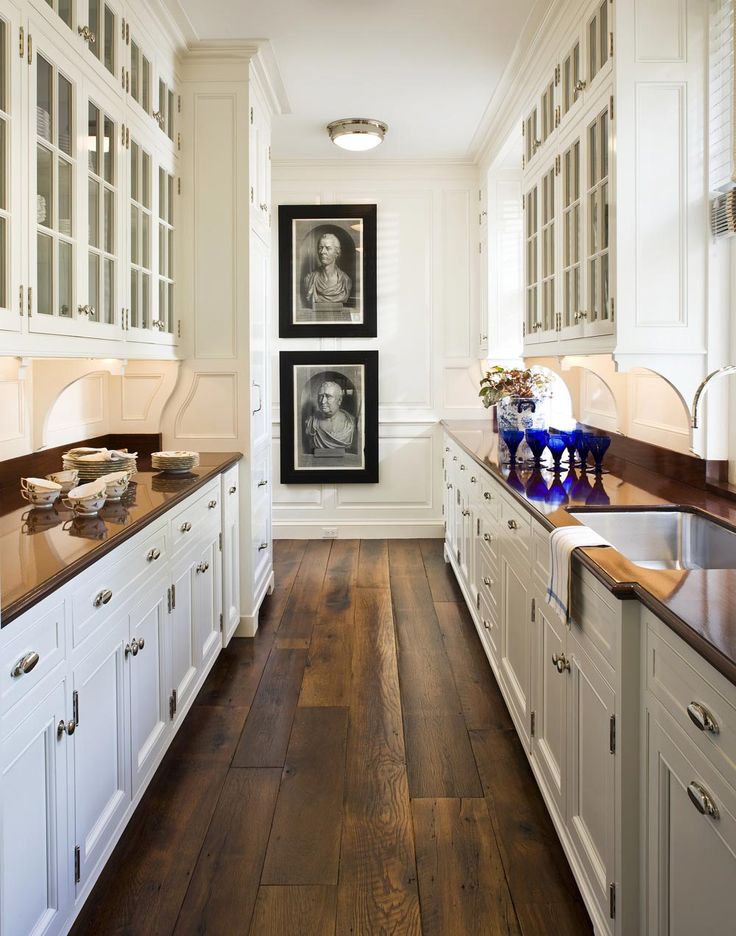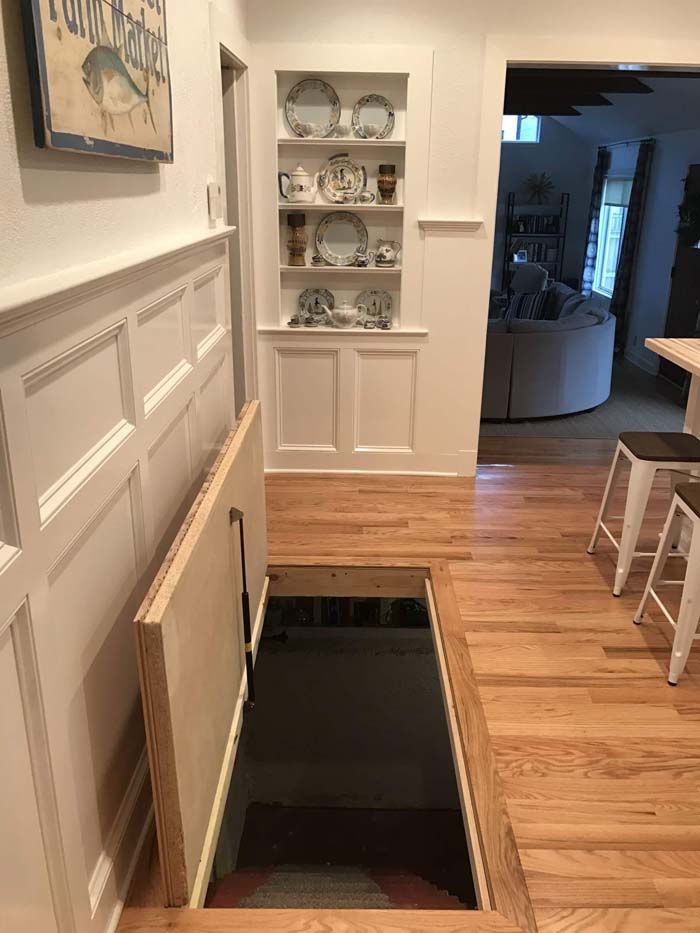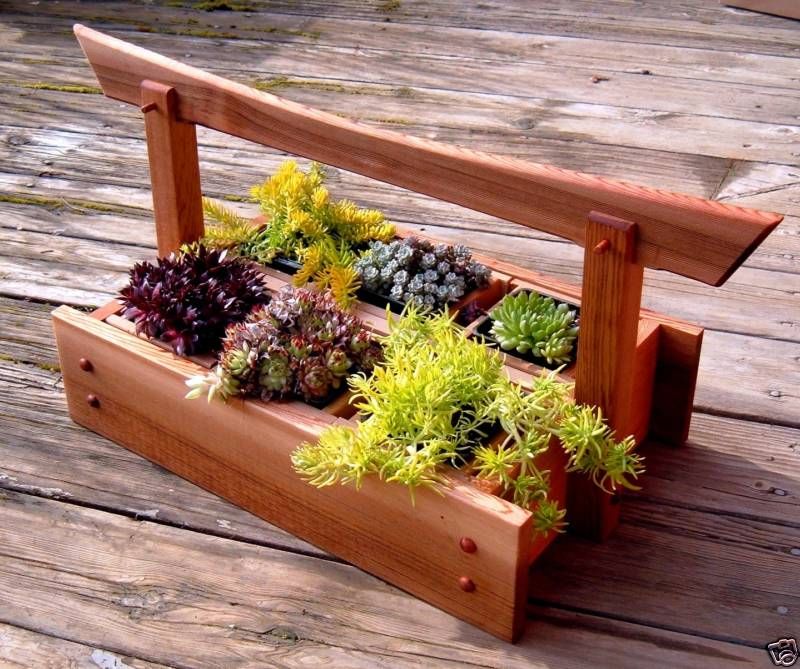A galley kitchen
What Is a Galley Kitchen?
If there was ever a misunderstood—and often maligned—kitchen layout, it would have to be the galley kitchen. It's called a galley kitchen after the efficient “galley” kitchens of railway dining cars. In the home, it's a classic kitchen layout that's versatile, durable, simple, and about as ergonomically correct as you can get.
What is a Galley Kitchen?
A galley kitchen is a long, narrow kitchen layout with services on one or both sides. An aisle runs down the center of a galley kitchen. Sometimes, the galley kitchen dead-ends at one end or it can be a pass-through kitchen.
If you're remodeling, a galley kitchen can work beautifully as one of the most functional spaces in the home. Even though galley kitchens are space-savers and usually fit the need for small kitchen areas, you might even want to consider installing one in a larger space simply because it works so well.
Galley Kitchen Basics
A galley kitchen is a long, narrow kitchen that has base cabinets, wall cabinets, counters, or other services located on one or both sides of a central walkway. Less often, a galley is called a corridor kitchen because its main traffic lane is a long, narrow aisle.
The countertops can be interspersed with appliances like fridges, sinks, cabinetry, and other functional items.
Since galley kitchens are small, they tend to be less expensive to build or remodel than other kitchen layouts. Also, galley kitchens are ergonomically better than some other kitchen design layouts since key services are clustered near each other. This means that walking toward or reaching for items between the refrigerator, stove/oven, and sink is kept to a minimum.
Galley Kitchen Pros and Cons
Pros
Space and cost savers
Tight cluster of essential kitchen services
Good use of classic kitchen triangle design
Less kitchen flooring to purchase and install
Perfect for do-it-yourself remodeling
Lower cost on cabinets and counters means more money for other items
Cons
Not good for more than two cooks at a time
Less countertop and storage space
Lower resale value
Standard sink configurations recommended
Hard to fit larger size appliances
Poor traffic flow when it's a dead-end galley kitchen (open only on one end)
Pros
There are plenty of advantages to a galley kitchen.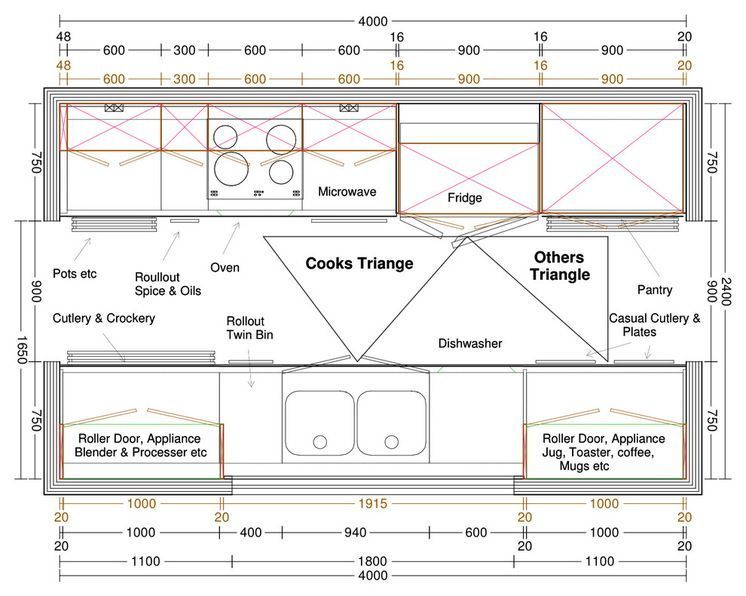 For one, a galley kitchen saves space so that other rooms in your home can be more spacious. The layout keeps the major kitchen services such as water, electrical, and gas clustered in the same area using the work triangle. Doing so makes it easier for plumbers and electricians to install or service appliances.
For one, a galley kitchen saves space so that other rooms in your home can be more spacious. The layout keeps the major kitchen services such as water, electrical, and gas clustered in the same area using the work triangle. Doing so makes it easier for plumbers and electricians to install or service appliances.
Because countertops and cabinets are the most expensive elements in the kitchen, this cost is drastically minimized in the smaller space. Less floor space means less kitchen flooring that you need to purchase. Finally, because you don't have to spend as much money on pricey countertops, cabinets, and flooring, more money is freed up to spend on appliances, the sink, or on other parts of your house.
Since galley kitchens are smaller, they tend to be slightly easier for do-it-yourself remodeling if the layout is simple with two banks of cabinets with straightforward, rectangular countertops.
Cons
There are a few drawbacks to a galley layout, one of which is that it tends to be too tight for multiple cooks to work at the same time since the space is narrow.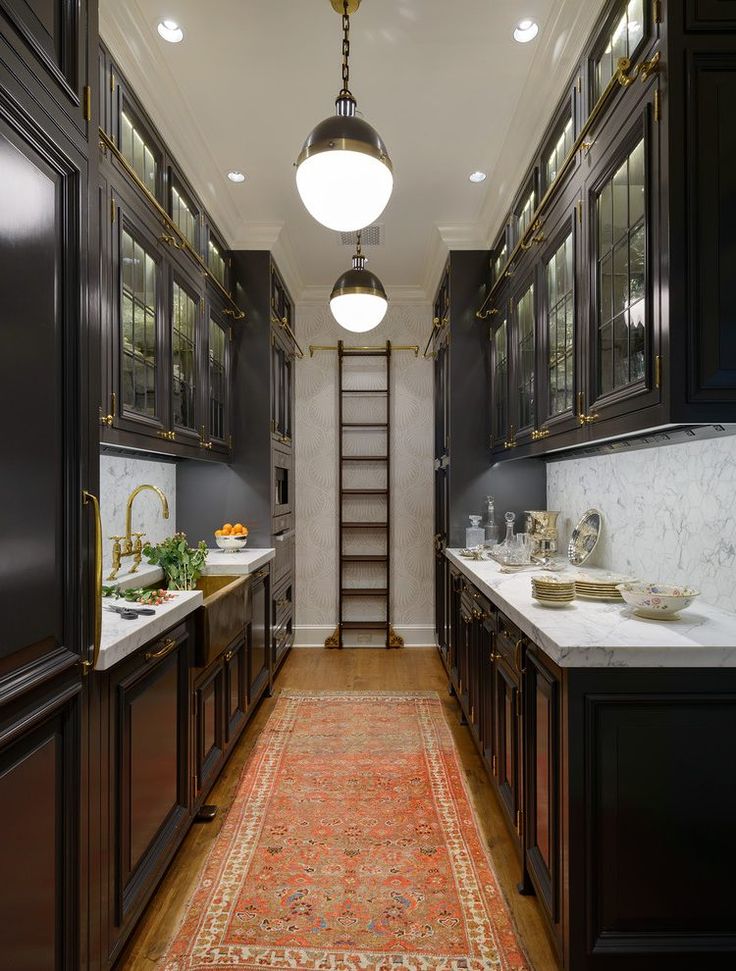 Countertop and storage space can be limited in a galley kitchen because there are fewer base cabinets. Clutter can quickly build up and prep space may be restricted.
Countertop and storage space can be limited in a galley kitchen because there are fewer base cabinets. Clutter can quickly build up and prep space may be restricted.
Resale value may be lower for homes with galley kitchens than for houses with other types of kitchen layouts because homeowners tend to prefer larger gourmet kitchens. Since people tend to gather in a kitchen when entertaining, galley kitchens are perhaps the least welcoming kitchen design when it comes to accommodating guests.
Galley Kitchen Design Considerations
A galley kitchen needs to be designed with thought to its scale. For example, appliances usually should be kept to standard sizes to avoid overcrowding in a galley kitchen. This type of kitchen makes excellent use of the tight, step-saving kitchen triangle design. Typically, the stovetop and refrigerator will be on opposite walls of a galley kitchen, though the refrigerator may be best at one end of a wall. Here are other considerations when planning and designing a galley kitchen.
Keep to the Basics
When building or remodeling a galley kitchen, stay with basics such as upper and lower cabinets, counters, refrigerator, sink, stove/oven, and a dishwasher. There is also typically no room in a galley kitchen for a permanent, full-size kitchen island or breakfast bar. However, you may have options. if there's room, a mobile island at the end of the kitchen may be a good compromise. If there's a window at the end of the kitchen, add a fold-out wall-mount table and a stool for a tiny eating nook.
Minimize Sink Size
Oversized farmhouse sinks or sinks angled at 45 degrees are difficult to fit into most galley kitchens. Instead, look for scaled-down sinks and keep sinks parallel to the counters. Drop-in sinks with built-in rims take away even more countertop space. Instead, consider installing an undermount sink so that the countertop can extend all the way to the sink edge.
Use Space-Saving Devices
Running kitchen cabinets to the ceiling maximizes storage space which is important in a smaller kitchen.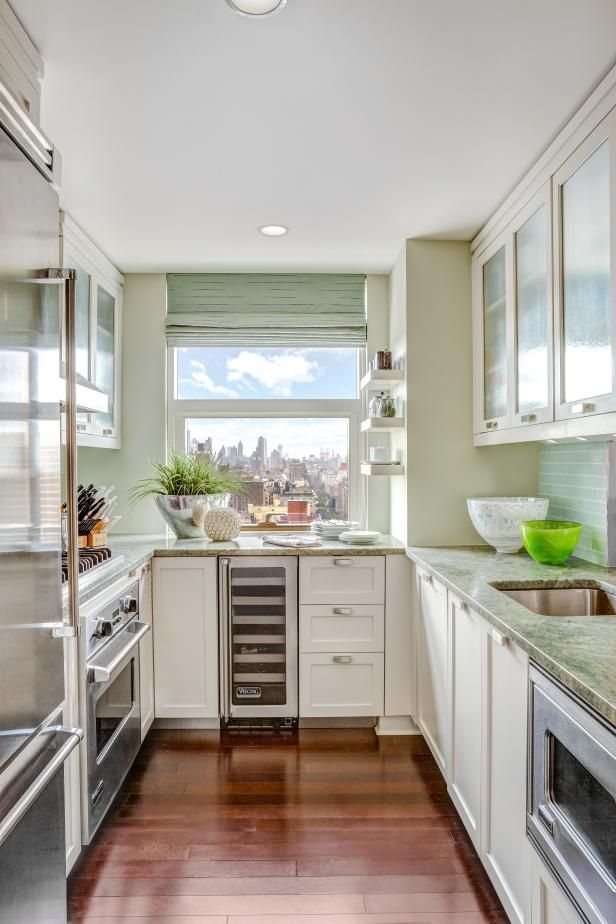 Keep to lighter-toned cabinets, some with glass doors to avoid an imposing presence in a galley kitchen. For lower cabinets, make use of lazy-Susans and roll-out shelves to better utilize that often-wasted space at the back of cabinets.
Keep to lighter-toned cabinets, some with glass doors to avoid an imposing presence in a galley kitchen. For lower cabinets, make use of lazy-Susans and roll-out shelves to better utilize that often-wasted space at the back of cabinets.
Consider Removing a Window
You can lose a window in a galley kitchen to gain more upper cabinet space. To decide whether you want to remove the window, think about whether the effort and expense will be worth the extra cabinet space. Does the window give you ample natural light and air, and will it be too dark in the space with it gone? If you decide to take out the window, you may need to call in a professional to remove the window, add drywall and insulation, then install a bank of cabinets inside. Outdoors, the space needs to be closed up with siding.
Think About Aisle or Walkway Width
The aisle or walkway running the length of a galley kitchen is its backbone. The space between opposite counters, or the walkway itself, should be a minimum of three feet.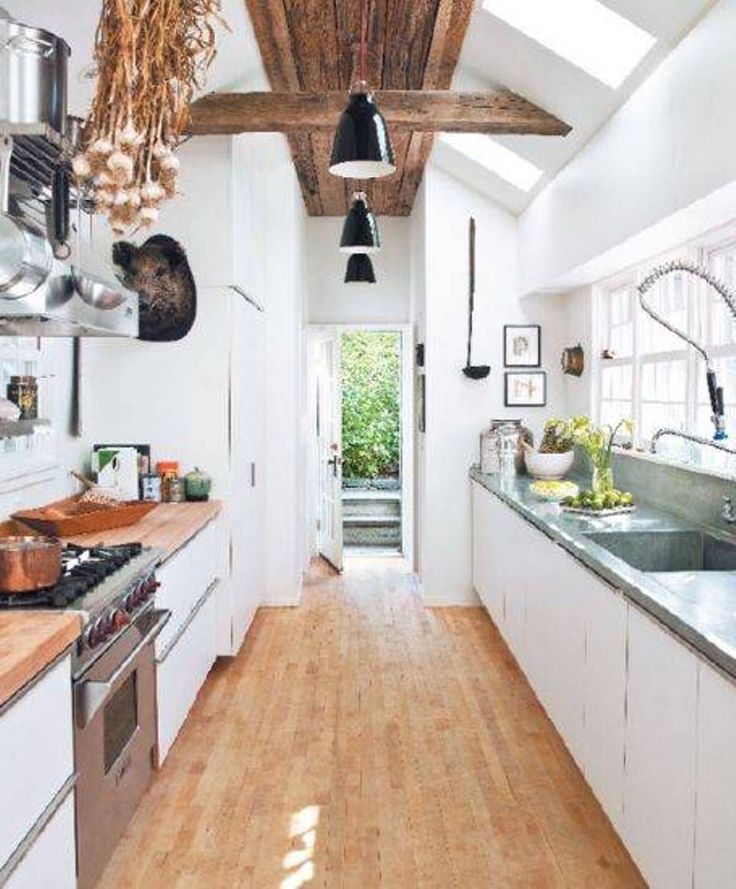 Even more importantly, accessibility can become an issue for those who use wheelchairs or walkers. If aisle width is an issue, consider clustering all of the services on one side of the kitchen only.
Even more importantly, accessibility can become an issue for those who use wheelchairs or walkers. If aisle width is an issue, consider clustering all of the services on one side of the kitchen only.
Use Light, White, and Neutral Colors
Lighter tones can make your galley kitchen feel much larger. Use light and bright materials for counters, cabinets, flooring, and wall paint. Even appliances should be shiny or matte white or stainless steel. For example, consider unstained or lightly stained maple, birch, or bamboo cabinets or white cabinets and countertops to keep the space streamlined, airy, and light.
45 Galley Kitchen Ideas That Are Practical and Chic
The Spruce / Leticia Almeida
Galley kitchens are often seen as dated and cramped, relics from a time before open plan kitchens ruled the day. Inspired by the compact, space-saving kitchens on boats, trains, and planes—in which long, narrow rows of cabinetry and appliances are placed on opposite walls with a central walkway in between them—these efficient spaces are often found in older city apartments and historic homes.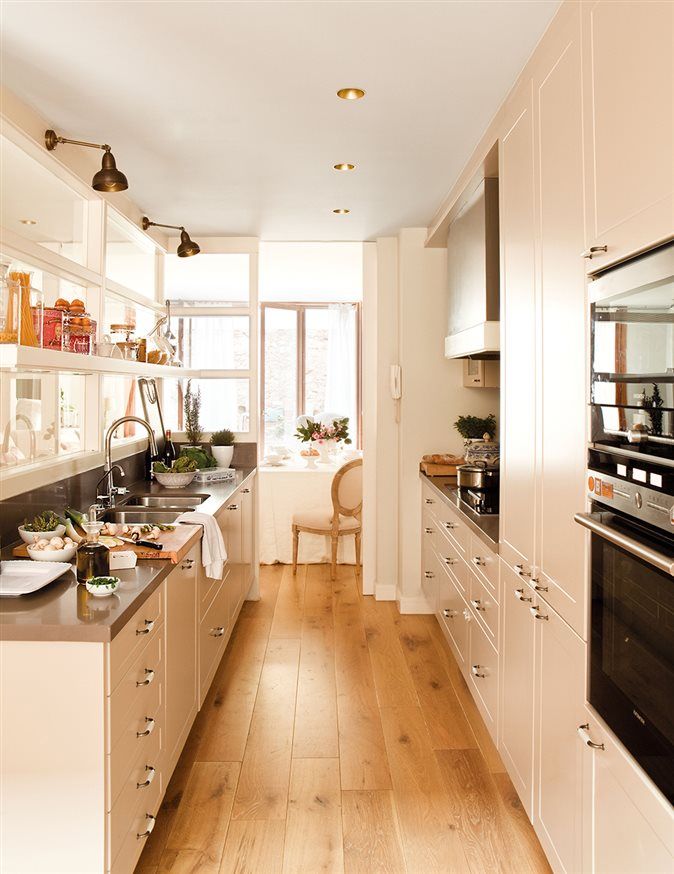 Galley kitchens appeal to those who enjoy having a self-contained area for meal prep where everything is located within arm's reach, plus the added benefit of banishing kitchen messes out of sight from the main living space.
Galley kitchens appeal to those who enjoy having a self-contained area for meal prep where everything is located within arm's reach, plus the added benefit of banishing kitchen messes out of sight from the main living space.
Check out these galley kitchen ideas in a range of homes that prove that this classic style can be both practical and surprisingly chic.
-
01 of 45
Use Dark Cabinetry
Fantastic Frank
This sleek Stockholm galley kitchen from Fantastic Frank has dark charcoal flat-front European-style cabinetry that creates a chic and cozy grounded feel that sets the cooking area apart from the light and bright main space. A seamlessly built-in oven at eye level makes it easier to keep an eye on things without having to do squats to see if the cake is ready in the narrow space, adding an extra layer of efficiency.
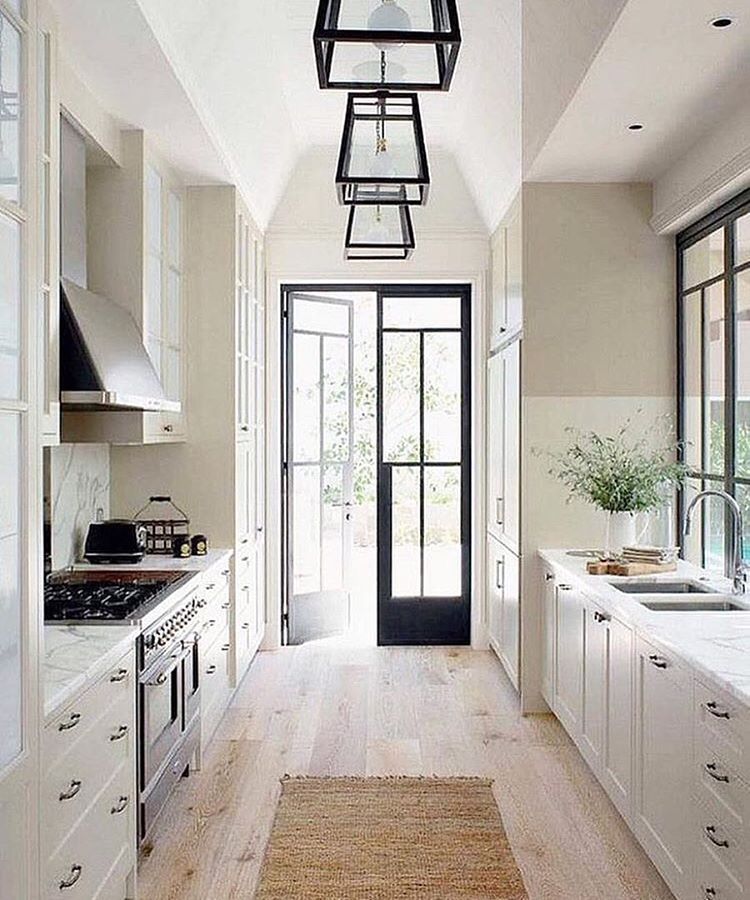
-
02 of 45
Go All White
Design by Leanne Ford Interiors / Photo by Reid Rolls
This galley-style kitchen from Leanne Ford Interiors has crisp white walls, gleaming white backsplash tiles, immaculate white countertops, and all-white cabinetry, open shelving, and appliances, creating a clean, bright backdrop for meal prep. Red accents add a shot of energy, and hardwood flooring adds warmth.
-
03 of 45
Make It Streamlined and Sober
Design by Caroline Andreoni Interior Design / Photo by Sophie Lloyd
This sleek and streamlined Paris galley kitchen from Caroline Andréoni Interior Design has a sober palette of matte navy and chocolate brown tones. Built-in cabinetry houses the oven and hides the refrigerator, and provides storage to keep the space clutter-free. White marble countertops and large scale concrete effect floor tiles lighten things up.
-
04 of 45
Paint It Peach
Design by Pluck
In this cheerful galley kitchen from Pluck, a wash of summery peach on the cabinetry and blush-toned paint on the walls creates a happy, warm, feel-good vibe.
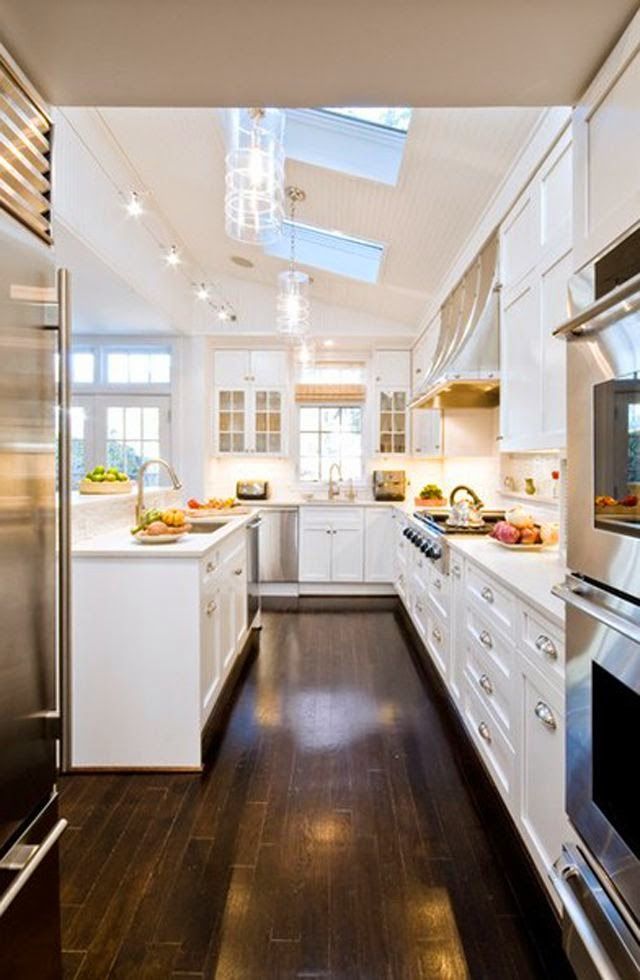 The space is wide enough to provide plenty of room in the central walkway to make it comfortable for several people to use at once.
The space is wide enough to provide plenty of room in the central walkway to make it comfortable for several people to use at once. -
05 of 45
Add a Balcony
Fantastic Frank
This Swedish galley kitchen from Fantastic Frank opens onto a small balcony that makes it feel twice as big when the doors are flung open, creating an opportunity for al fresco dining and a spot for morning coffees and nightcaps after dark.
-
06 of 45
Add a Corner Banquette
Design by Georgia Zikas Design / Photo by Jane Beiles
In this galley-style city apartment kitchen from Georgia Zikas Design, a corner banquette is squeezed in at the far end beneath a window with a skyline view. A round tulip-style table without any sharp edges allows for easy maneuvering in the compact space. Glass-front cabinetry helps keep the narrow galley kitchen from feeling too closed in, and a gleaming tile backsplash on opposite walls helps to bounce light around.
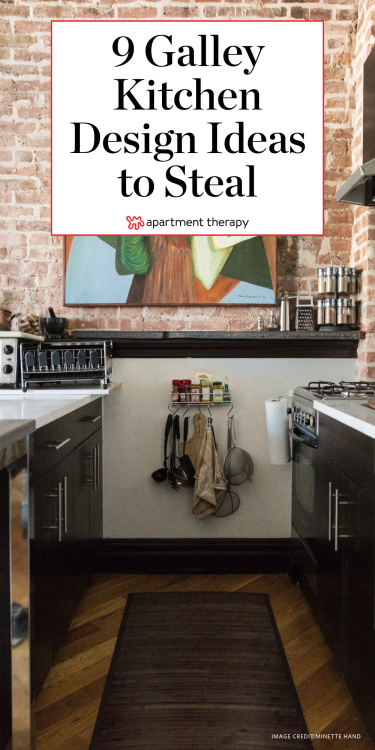
-
07 of 45
Supersize It
Design by Julian Porcino
In this spacious California galley kitchen from real estate agent and interior designer Julian Porcino, a neutral palette mixed with natural wood and industrial touches creates a streamlined look. A pair of windows, a glass double door leading to the outside, and bright white walls and ceiling paint keeps the galley kitchen feeling light and bright. Apart from a floor-to-ceiling block of cabinetry at the far end built to house the refrigerator and provide extra storage, upper cabinetry was omitted to preserve a feeling of openness.
-
08 of 45
Add a Breakfast Bar
Design by deVOL Kitchens
Many galley kitchens have a window at the far end to let in natural light and air. If you've got the space, adding a place to sit and have a cup of coffee, or to take a load off while performing meal prep will make it more comfortable and functional. In this small galley-style kitchen in a Georgian style apartment in Bath, England, designed by deVOL Kitchens, a small cafe-style breakfast bar is built right next to the window.
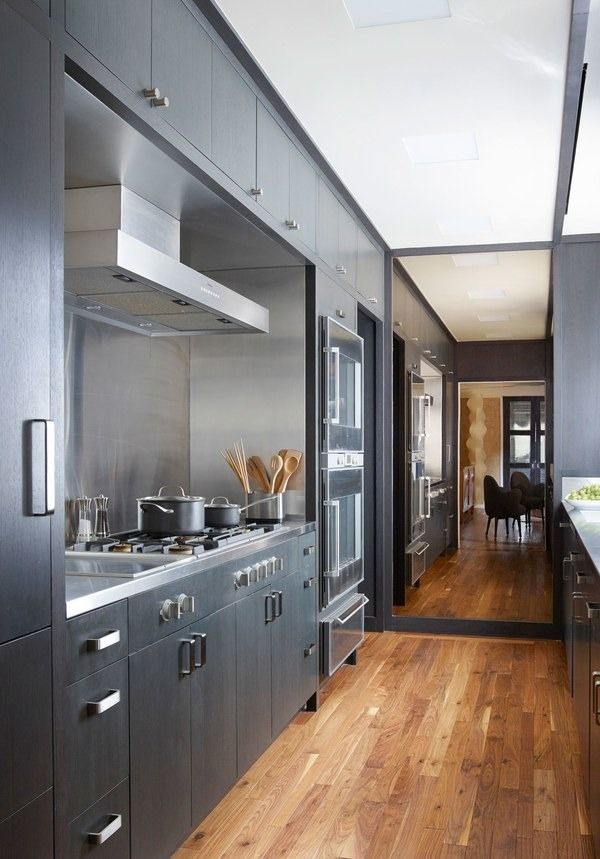
-
09 of 45
Add Some Color
Design by Cathie Hong Interiors / Photo by Margaret Austin Photo
In this midcentury modern California home kitchen renovation from Cathie Hong Interiors, robin's egg blue cabinetry helps define the galley kitchen that opens up into an eat-in dining space.
-
10 of 45
Open It Up
Design by Alvin Wayne
One way to modernize a galley style kitchen is to knock down one wall and add peninsula seating like this compact NYC space from interior designer Alvin Wayne that opens up the living area and increases light and views.
-
11 of 45
Maximize a Tiny Space
Fantastic Frank
Sometimes less is just enough. This compact Stockholm kitchen from Fantastic Frank maximizes every last centimeter of space by going vertical with open shelving and cabinetry. Small appliances and simple materials make the petite space perfectly functional, no renovation required.
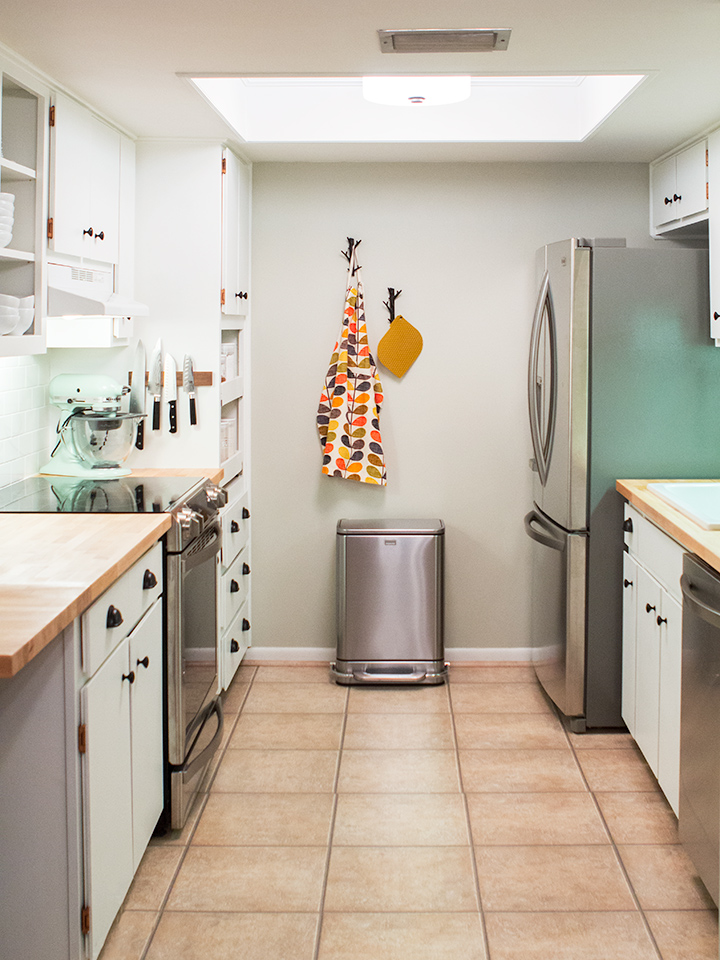
-
12 of 45
Add Black Cabinetry
Design by Cathie Hong Interiors / Photo by Amber Thrane
In this modern galley-style San Diego, CA, kitchen from Cathie Hong Interiors, black lower cabinets on both sides of the wide kitchen add a grounding element that anchors the light and bright space. A simple gray tile floor, stainless steel appliances, and bronze accents complete the clean design.
-
13 of 45
Add Statement Flooring
Design by Matthew Carter Interiors
The star element of this spacious galley kitchen from Lexington, Kentucky-based by Matthew Carter Interiors is the bold graphic parquet floor in a mix of pale and dark wood that adds personality and makes it memorable and inviting. A line of drop pendant ceiling lights emphasizes the long linear galley space while adding vintage charm.
-
14 of 45
Mix Color and Pattern
Design by Pluck / Photo by Malcolm Menzies
Bold turquoise paint and a black-and-white checkerboard floor adds contrast to the original brick wall and adds retro vibes to this London kitchen from Pluck.
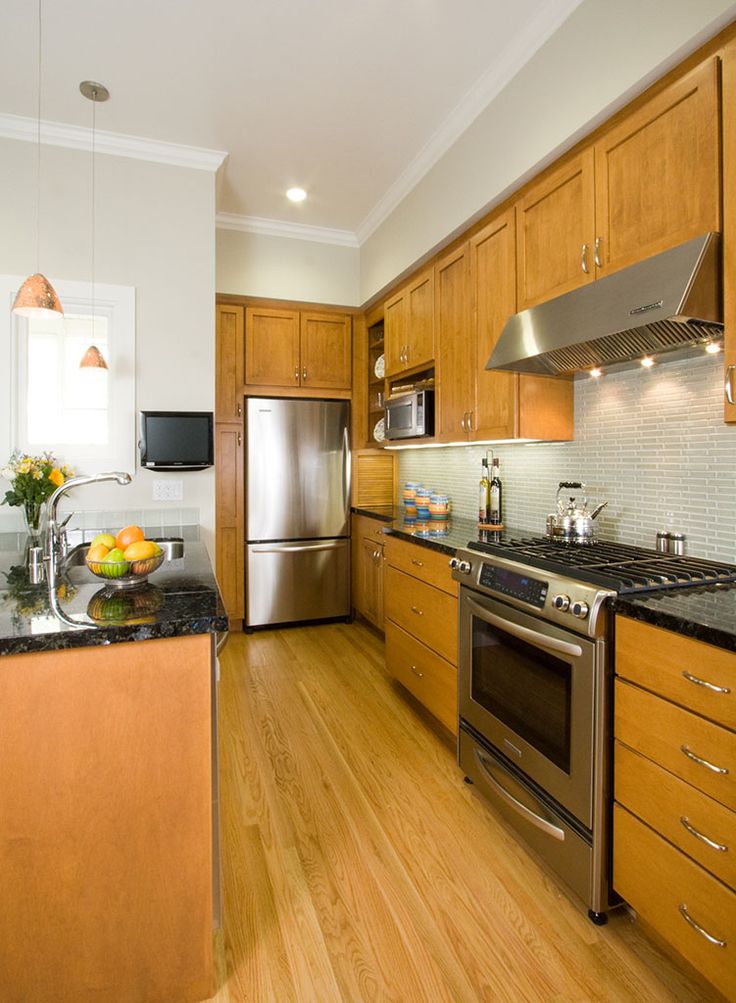
-
15 of 45
Use Floor Tile to Define Space
Design by Caroline Andreoni Interior Design Studio / Photo by Sophie Lloyd
Caroline Andréoni Interior Design Studio created a galley-style kitchen by positioning blocks of lower cabinetry opposite one another, defining the space with graphic diamond-patterned floor tile. A glass and metal atelier window creates a separation from the rest of the space while letting light flow through. And an accent wall of tropical wallpaper adds a focal point.
-
16 of 45
Add a Galley-Style Wing
Design by Marie Flanigan Interiors
Even in a large scale kitchen, adding a galley kitchen-style wing can make practical sense to create zones and make the overall space more efficient, like this spacious all-white space from Marie Flanigan Interiors.
-
17 of 45
Incorporate Negative Space
Design by Pluck / Photo by Malcolm Menzies
In this galley-style London kitchen from Pluck, the pass-through meal prep area has a block of mustard-colored lower cabinetry on both sides, but upper cabinetry confined to one side, leaving room for wall-mounted lighting and incorporating some negative space above the left wall of cabinetry that allows the room to breathe.
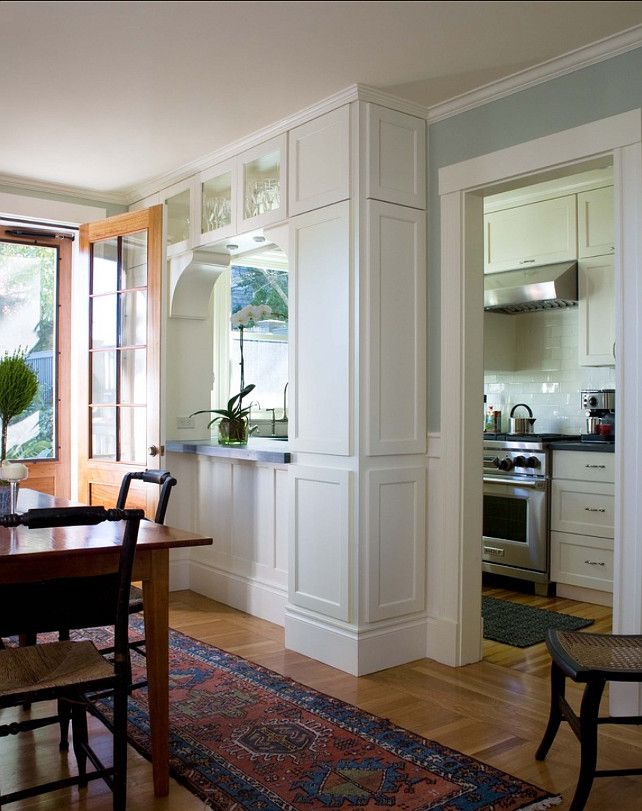
-
18 of 45
Add a Colorful Runner
Design by Desiree Burns Interiors
A colorful blue runner on the dark hardwood floors of this galley kitchen from Desiree Burns Interiors creates a focal point in the functional, all-white space.
-
19 of 45
Create a Breakfast Bar
Design by Neva Interior Design / Photo by Agathe Tissier
Neva Interior Design carved a compact galley kitchenette beneath the loft space in this 200-square-foot Parisian apartment that is practical and efficient, leaving room for small breakfast bar on the periphery.
-
20 of 45
Highlight Natural Wood
Design by Pluck / Photo by Malcolm Menzies
In this galley-style British kitchen from Pluck, hardwood floors and natural wood cabinetry add warmth that complements soft shades of white and industrial black accents like the metal-grid glass doors leading out to the garden.
-
21 of 45
Use a Galley Style Layout to Structure an Open Space
Design by Will Brown Interiors
Using a galley-style layout is one way to structure a modern open plan kitchen, like this one from Will Brown Interiors that pairs a wall of cabinetry and appliances with a kitchen island housing the sink and additional storage opposite, with a central walkway that preserves flow with the rest of the room.
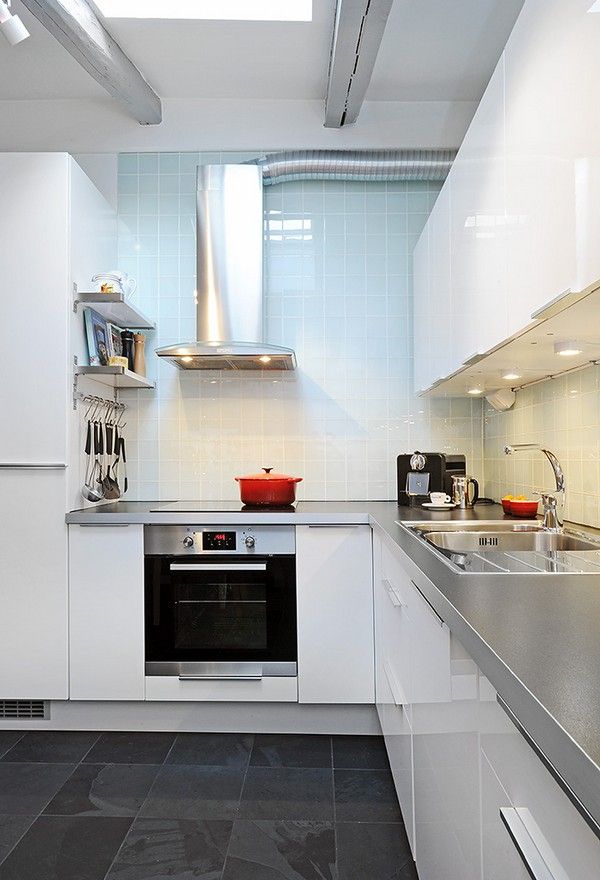
-
22 of 45
Work Around the Window
Design by Velinda Hellen for Emily Henderson Design / Photo by Veronica Crawford
On the opposite side of this galley-style kitchen designed by Velinda Hellen for Emily Henderson Design, the sink is positioned beneath a window that floods the narrow space with natural light. A wood-framed glass back door provides more light and views to the outside, to help prevent the space from feeling cramped.
-
23 of 45
Limit Upper Cabinetry
Fantastic Frank
This compact galley kitchen from Fantastic Frank retains a minimal feel by focusing the storage space on lower cabinetry, and adding airy white and wood open shelving to just one wall. A large French window provides plenty of natural light and a view of greenery that keeps the small space from feeling claustrophobic, and soothing gray paint and Edison bulb pendant lights add softness to the minimal space.
-
24 of 45
Use Vertical Space
Design by Velinda Hellen for Emily Henderson Design / Photo by Veronica Crawford
In this galley-style kitchen designed by Velinda Hellen for Emily Henderson Design, one wall features floor-to-ceiling built-ins around the oven that maximizes vertical space.
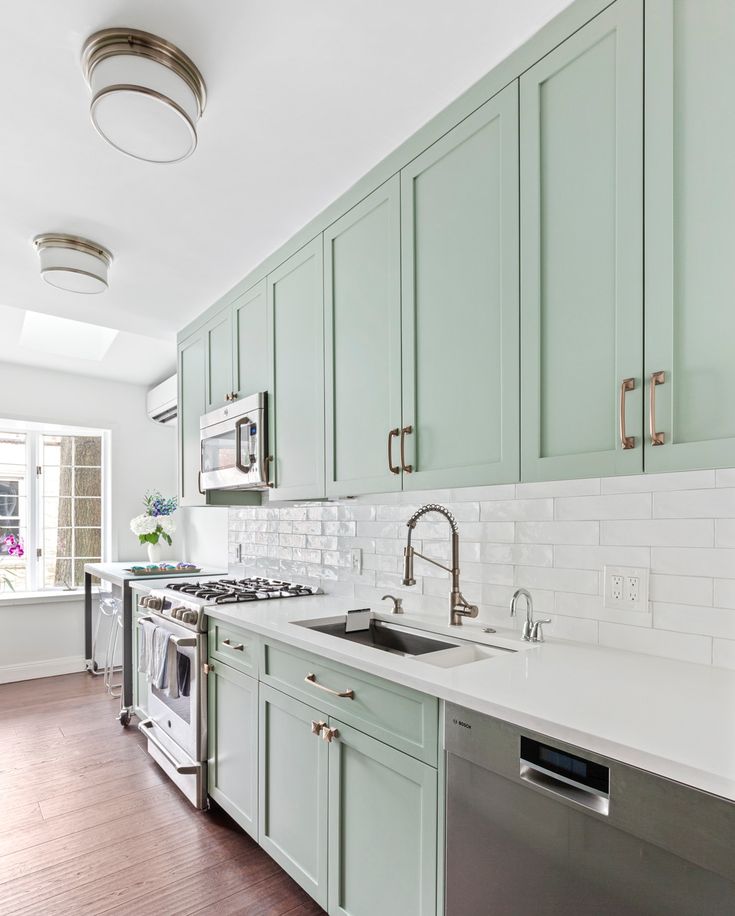
-
25 of 45
Make It Seamless
Design by Will Brown Interiors
This galley-style kitchen from Will Brown Interiors is tucked out of the way of the dining space while remaining easily accessible, with simple cabinetry, tones of gray, and hardwood flooring carried throughout the space that allows it to seamlessly blend into the rest of the decor.
-
26 of 45
Add a Waterfall Edge Countertop
Design by Yael Weiss Interiors
This sleek and streamlined Tribeca kitchen from NYC-based Yael Weiss Interiors has a waterfall edge stone countertop that adds polish to the neutral space with floor-to-ceiling built-ins in pale colors and high ceilings that creates an open and airy feel.
-
27 of 45
Add a Dropped Ceiling
Design by Alvin Wayne
In this opened up NYC galley kitchen from interior designer Alvin Wayne, a dropped ceiling adds an opportunity for built-in can lighting and helps define the space while preserving sightlines.
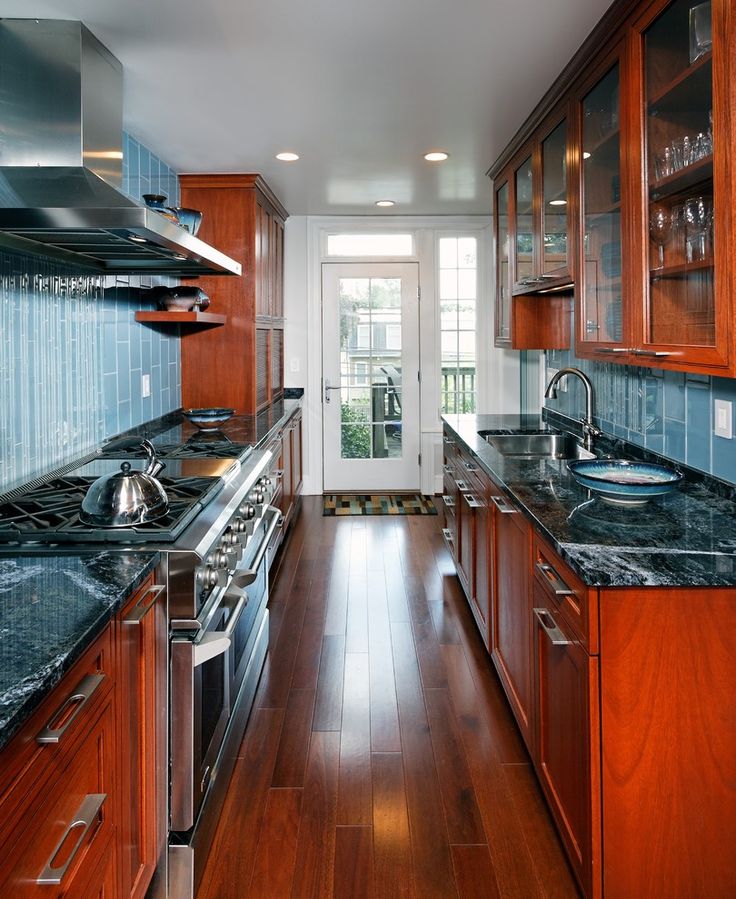
-
28 of 45
Use Pastel Colors
Design by deVOL Kitchens
In this galley kitchen designed by deVOL Kitchens, a large cased opening allows natural light from the adjacent room to flow in. To maximize space, the designers ran cabinetry and a built-in hood vent all the way up to the ceiling. A soft palette of off white, mint green, and natural wood keeps it feeling light and airy.
-
29 of 45
Shut the Door
Fantastic Frank
This galley kitchen from Fantastic Frank has a solid wood door for privacy and a wall of windows that floods the tight space with natural light. A neutral palette of whites and pale woods creates a natural, fresh feel.
-
30 of 45
Create an End Point
Design by Twelve15 Design Studio
In this galley-style kitchen from Twelve15 Design Studio, a small peninsula on one side creates an end point that helps define the space from the rest of the room while providing a space for breakfasts on the go.
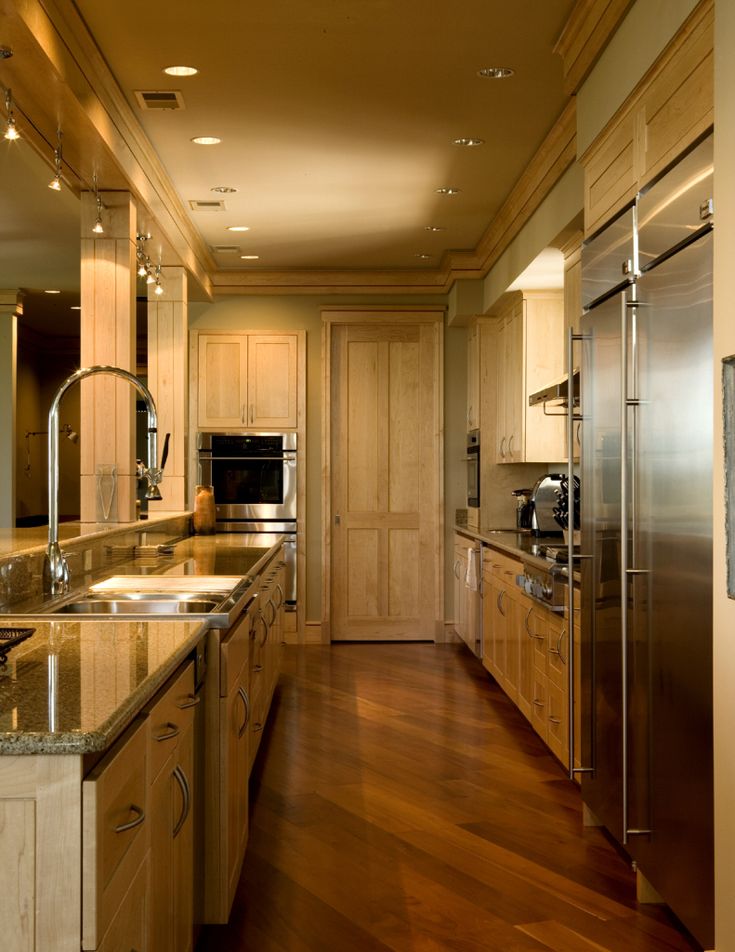
-
31 of 45
Add Bold Graphics
Design by Brady Tolbert for Emily Henderson Design / Photo by Tessa Neustadt
In this galley-style kitchen designed by Brady Tolbert for Emily Henderson Design, a bold black-and-white palette creates a graphic look, from the towering retro-style refrigerator to the wall decor and flooring.
-
32 of 45
Add Gold-Toned Accents
Design by Brady Tolbert for Emily Henderson Design / Photo by Tessa Neustadt
Gold-toned plumbing fixtures and hardware on cabinetry and open shelving add a light touch to this graphic black-and-white galley-style kitchen designed by Brady Tolbert for Emily Henderson Design.
-
33 of 45
Keep It Flowing
Fantastic Frank
Running the same hardwood flooring throughout the entire home gives this small Swedish pass-through galley kitchen from Fantastic Frank an effortless flow.
-
34 of 45
Add Peekaboo Shelving
Design by Maite Granda
Interior designer Maite Granda carved an efficient galley kitchen into a sprawling Florida home that is partially divided off from the main living space with peekaboo shelving and long, narrow windows above the sink and high up near the ceiling above the cabinets to let in natural light.
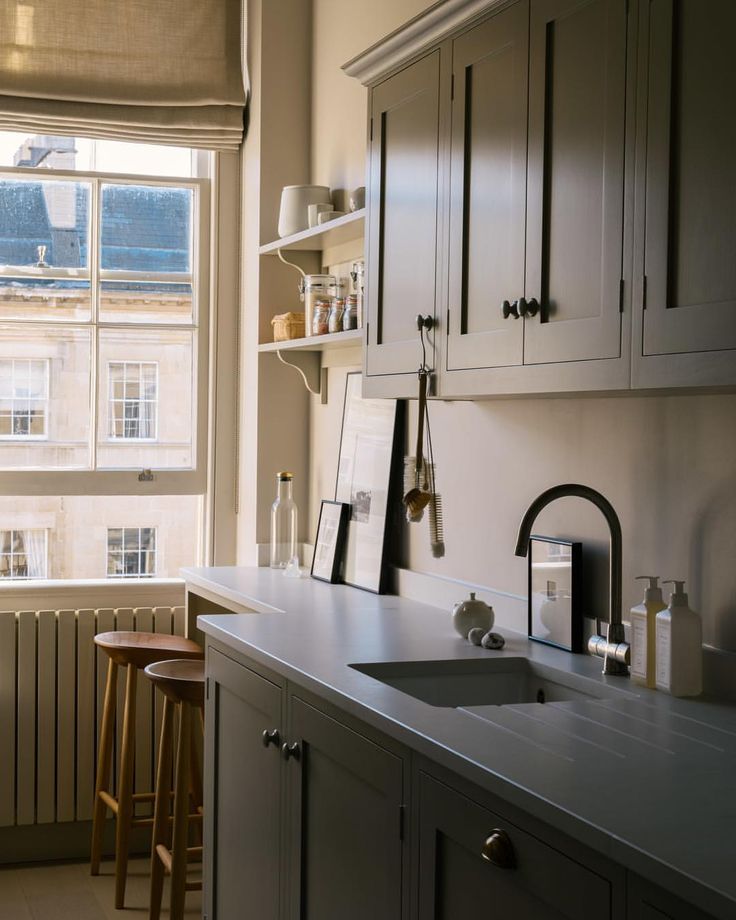 If you don't have the option of installing windows in your galley kitchen, try a mirrored backsplash instead.
If you don't have the option of installing windows in your galley kitchen, try a mirrored backsplash instead. -
35 of 45
Mix and Match
Design by deVOL Kitchens
While many galley kitchens use matching blocks of cabinetry on both sides, in this open space converted schoolhouse kitchen from deVOL Kitchens, a galley-style cooking area is defined with an industrial metal kitchen island housing the sink and stovetop on one side and a row of countertops and built-in wood cabinetry on the other.
-
36 of 45
Work Around the Architecture
Design and Photo by Officine Gullo
This Tuscan kitchen from Italy's Officine Gullo is painted in sunflower yellow and outfitted with high end steel and chrome-plated brass appliances, adding contrast to the rustic bones of the galley-style space with its warm wood ceiling beams and original stone wall.
-
37 of 45
Shut the Back Door
Design by Rashida Banks for Emily Henderson Design / Photo by Keyanna Bowen
In this kitchen designed by Rashida Banks for Emily Henderson Design, a black slate floor defines the galley kitchen space and adds contrast with the natural wood and glass back door.
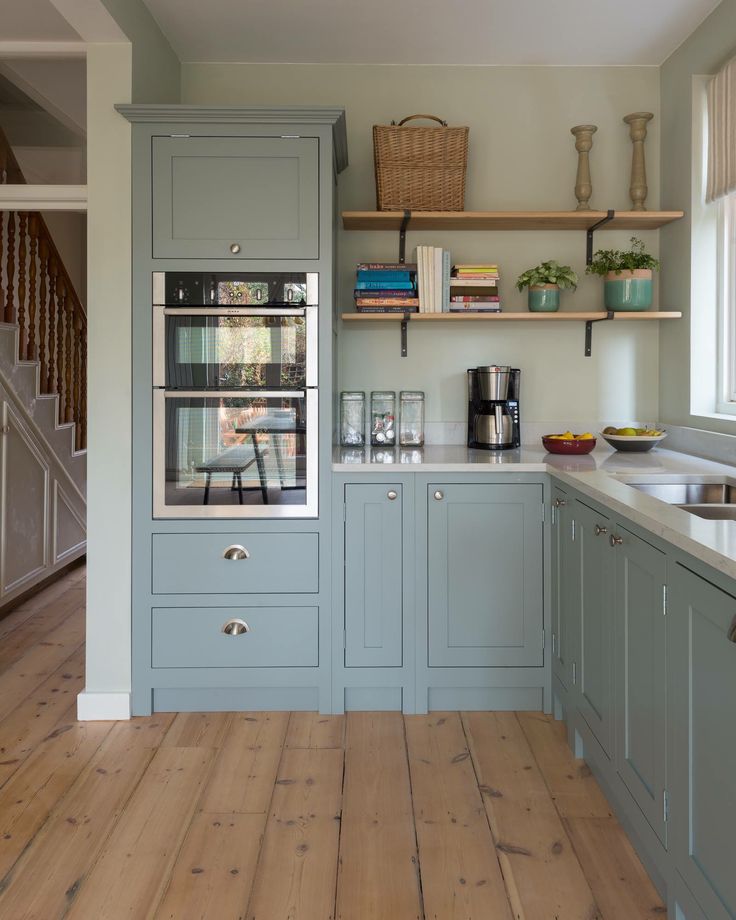
Best Kitchen Design Software
-
38 of 45
Add a Vintage Touch
Design by Mindy Gayer Design Co.
A vintage-style runner adds a timeless element to this classic all-white kitchen from Mindy Gayer Design Co., with a galley-like central workspace housing the sink and oven and a massive built-in refrigerator relegated to the far wall.
-
39 of 45
Add Texture
Design by deVOL Kitchens
In this streamlined and contemporary galley-style kitchen designed by Sebastian Cox for deVOL Kitchens, black wood cabinetry with a Shou Sugi Ban aesthetic adds texture, depth, and contrast against the pale walls and flooring. The room's abundance of natural light keeps the dark wood from feeling heavy.
-
40 of 45
Set a Table for Two
Fantastic Frank
This partially deconstructed Swedish galley kitchen from Fantastic Frank has cabinetry and appliances on opposite walls that work around the irregular bones of the room, leaving space for a cozy bistro-style table for two at the far end beneath the large window that floods the space with natural light.
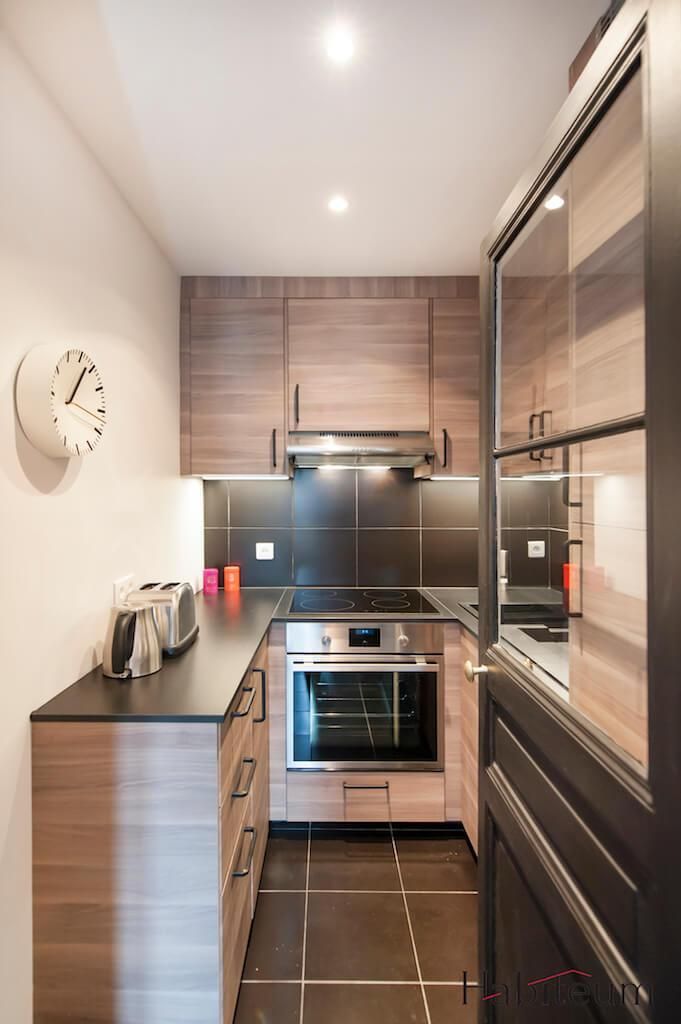
-
41 of 45
Create a Through Line
Design by deVOL Kitchens
In this Victorian villa from deVOL Kitchens, a long, wide pass-through galley-style kitchen includes opposite walls of cabinetry and appliances on the far end, and space for a dining table and sofa on the other. Classic checkerboard flooring links the space and the layout of furniture and built-ins allows enough room for a central corridor that preserves flow, making the cozy space functional.
-
42 of 45
Keep It Light and Bright
Fantastic Frank
This understated Scandinavian kitchen from Fantastic Frank has practical floor-to-ceiling built-in cabinetry, warm wood countertops, and a soft white palette that blends seamlessly with the adjoining dining area that is flooded with natural light from a large window. A bright yellow pendant light adds a focal point above the dining table.
-
43 of 45
Add Intrigue to the Floor
Design by Neva Interior Design / Photo by Agathe Tissier
In this long, narrow Paris apartment, Neva Interior Design built a an open galley kitchen with a penny tile floor that blends into the hardwood floors of the main space, and preserves the flow of a narrow central walkway leading to the front door.
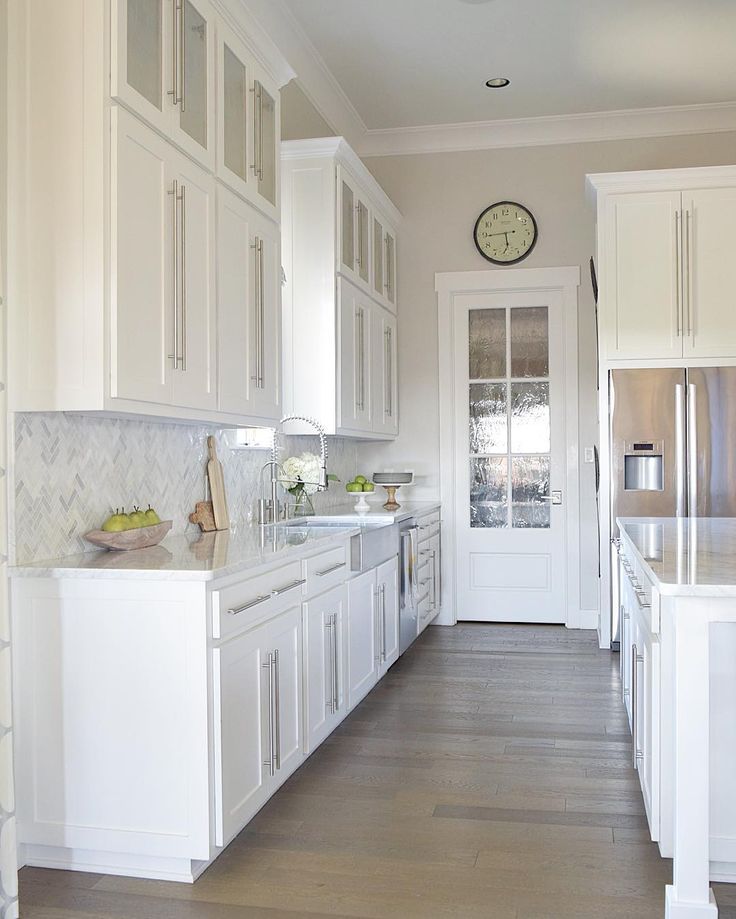
-
44 of 45
Embrace Irregularities
Fantastic Frank
This galley-style Scandinavian kitchen from Fantastic Frank is built around the irregular curves of the existing architecture, with appliances and countertops that hug the curve of the walls in order to maximize space while leaving enough room to circulate.
-
45 of 45
Honor Historical Character
Design by Julian Porcino
This adobe-style home and Los Angeles historical landmark built in 1922 from estate agent and interior designer Julian Porcino features a carefully updated galley-style kitchen that honors the original character of the home.
52 Small Kitchen Ideas That Prove That Less Is More
10 steps to create it
The galley kitchen is a well-known two-row or two-line layout. It is also called parallel. But for now we will use the beautiful name "galley".
Photo: decorhint.com
What you need to know before you start organizing such a galley kitchen? To begin with, it is important to understand how many square meters you have at your disposal.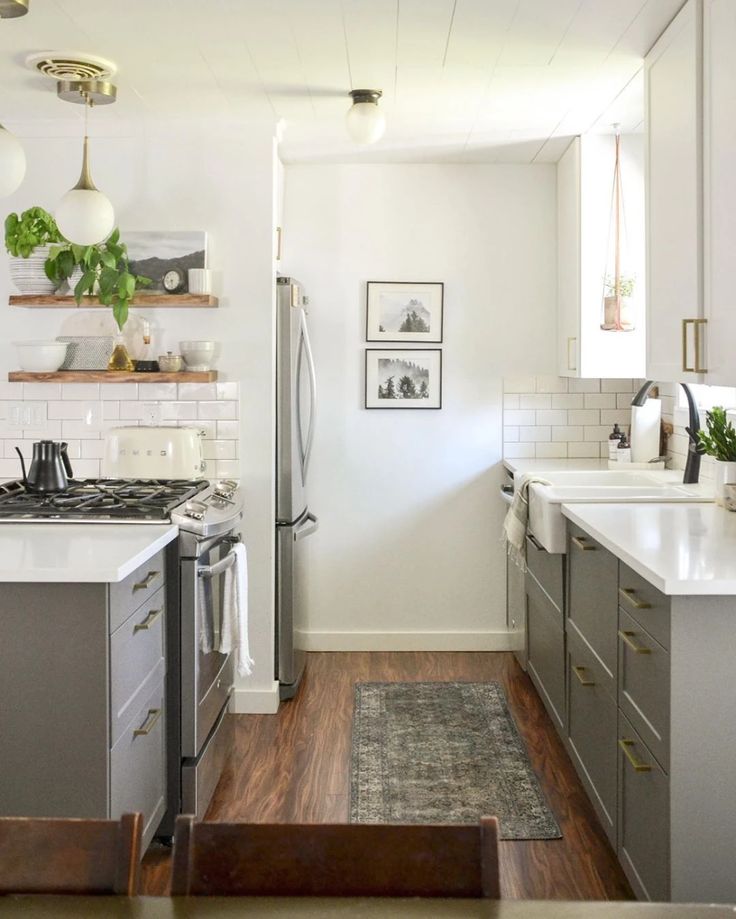 Such a layout is optimal with a room width of at least 220 centimeters - this is exactly what is needed to accommodate two rows of furniture 60 centimeters deep and the minimum allowable hundred-centimeter passage between them.
Such a layout is optimal with a room width of at least 220 centimeters - this is exactly what is needed to accommodate two rows of furniture 60 centimeters deep and the minimum allowable hundred-centimeter passage between them.
Calculate the exact cost of repairs on the online calculator
and get a free detailed estimate for repairs
Calculate
pantry adjoining the kitchen. The main thing is that there are technical possibilities for this. Another interesting option for arranging a galley is to allocate part of the space for it in a studio apartment. Moreover, this can be done both as a forced measure to save space, and to combine the dining and kitchen areas.
Photo: home-designing.com
There are several rules without which you will not be able to equip a classic, that is, the correct galley kitchen. The rules are simple, but you need to remember them:
- provide a working triangle zone - this is an imaginary line between the most important appliances in the kitchen: a refrigerator, stove and sink.
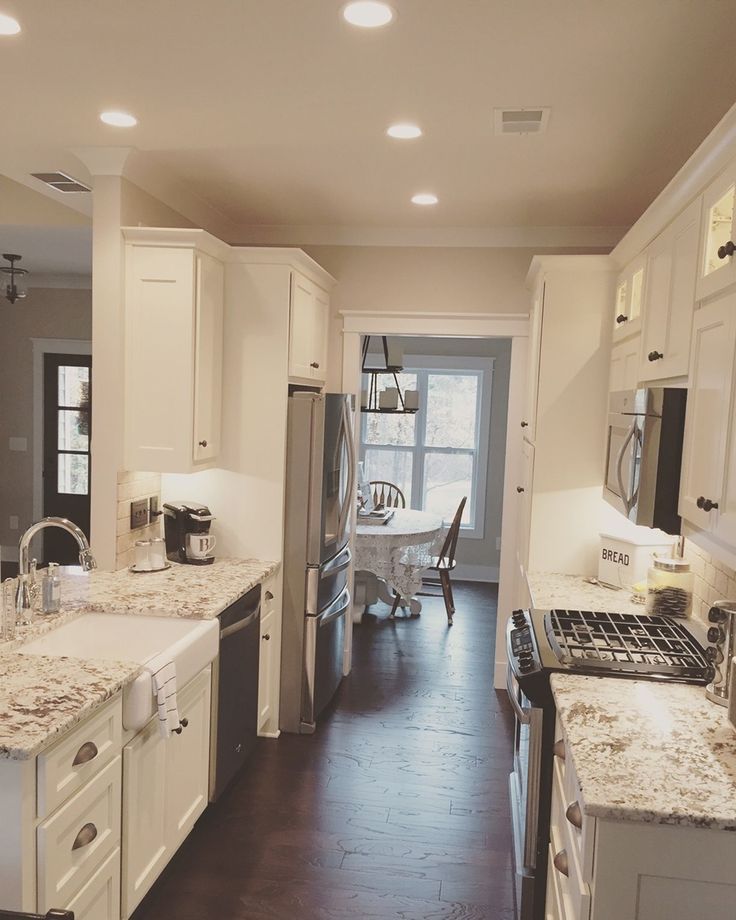 You should be able to reach each of these three objects in one step, maximum two;
You should be able to reach each of these three objects in one step, maximum two; - popular galley layouts include a sink and refrigerator on one side and a stove on the other;
- open high shelving will help optimize the situation in such a kitchen and most effectively accommodate everything you need;
- it is better to choose light colors of cabinets and wall finishes in order to at least slightly expand this narrow space visually;
- dishwasher and refrigerator can be paneled for a neater appearance;
- deep pull-out drawers will increase the usable amount of space.
Photo: home-designing.com
We told you about the recommendations of the designers, and on our own we will add: any rules can be broken to create a truly original and comfortable kitchen, even if the room is too cramped. In the end, it is you who should be comfortable here and enjoy cooking.
Photo: home-designing.com
And now let's talk in detail about ten steps to create a galley kitchen in different areas of the apartment.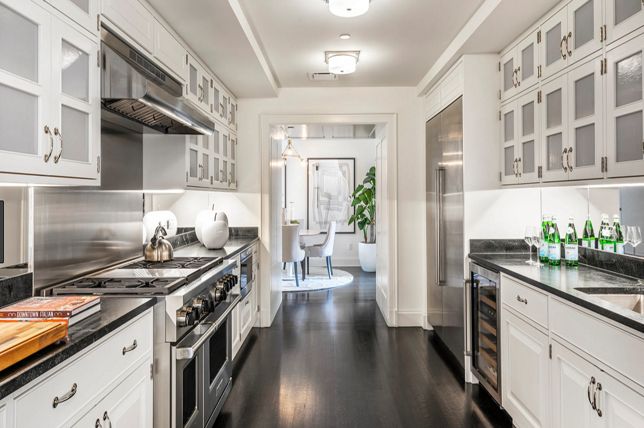
1. Location of items
Ideally, it is better to place the stove, sink and main work surface in the same row, and install the refrigerator opposite. Crowding is the main enemy of such a kitchen. But such a technique will help protect you and your loved ones from injury and burns if someone goes to the refrigerator. Otherwise, there is a risk of accidentally touching a hot pan or pot on the stove. Yes, and it will be more convenient for you to operate in a small space without unnecessary gestures.
Photo: home-designing.com
2. Passage width
Be sure to measure the width and length of your future galley before starting any work. Perhaps you will change your mind about placing the kitchen in this space and think about another option. If the passage between two rows of furniture is less than a meter, you will not be able to freely use the contents of drawers and shelves. Moving here will also be inconvenient. It is better if the width of the passage is from 120 to 150 centimeters.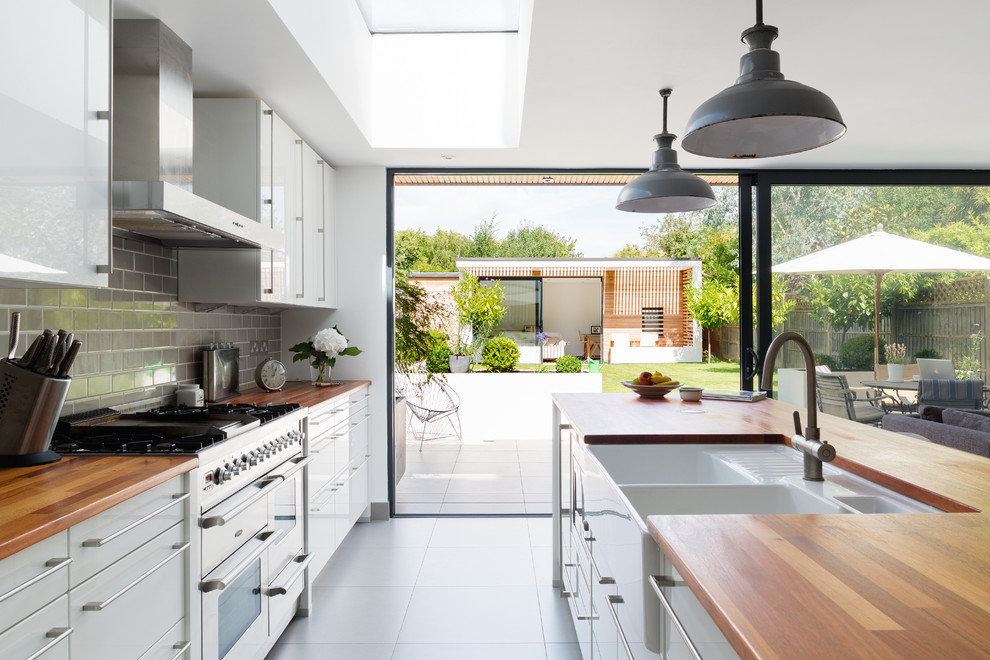 Then your loved ones will be able to pass by you and not hurt anything, fall down or break anything. And you won't be interrupted when you stand at the stove or load the dishwasher.
Then your loved ones will be able to pass by you and not hurt anything, fall down or break anything. And you won't be interrupted when you stand at the stove or load the dishwasher.
Photo: home-designing.com
3. Length of rows
If every centimeter counts in your narrow kitchen and you can't arrange two parallel full rows, make one of the rows shorter than the second. So you can carve out more space for a refrigerator, side table or shelving. This will help to slightly expand the too narrow passage.
Photo: decorhint.com
4. Compact Kitchen Appliances
If the manipulation of the rearrangement does not help to accommodate everything you need, you will have to choose more compact appliances: a two-burner stove, a narrow refrigerator, a small dishwasher, a small sink, a shorter work surface.
Photo: home-designing.com
5. Cabinets to the ceiling
A great way to create additional storage space and at the same time hide the air duct in the upper tier.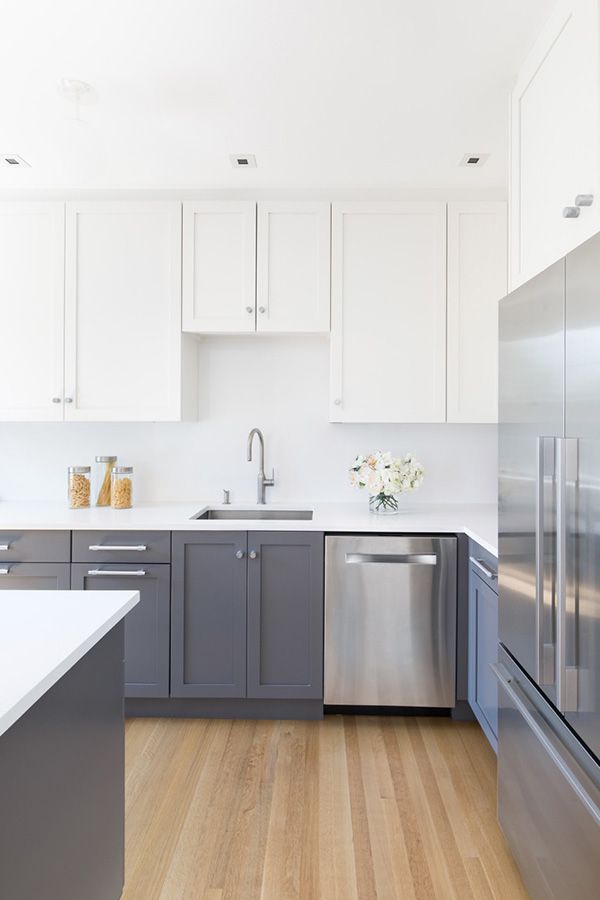 To maintain visual volume in the galley, choose narrow cabinets with matte light doors.
To maintain visual volume in the galley, choose narrow cabinets with matte light doors.
Photo: decorhint.com
6. Drawers instead of hinged cabinets
When arranging the lower tier of kitchen furniture, give up models with hinged doors - you do not have to block the passage with them in an attempt to find the right thing in the far corner of the cabinet.
Photo: home-designing.com
7. Furniture to match the walls
Even if you don't like pure white, which, of course, visually saves space, make at least one wall in the same shade as the kitchen cabinets . This technique effectively reduces the feeling of clutter.
Photo: home-designing.com
8. Multilevel lighting
Thoughtful lighting scenarios can dramatically change the look of your galley. Naturally, for the better. Do not place a massive chandelier or lamp on the ceiling. Choose small lamps or spots, place them at different levels. Be sure to provide lighting for the cooking area.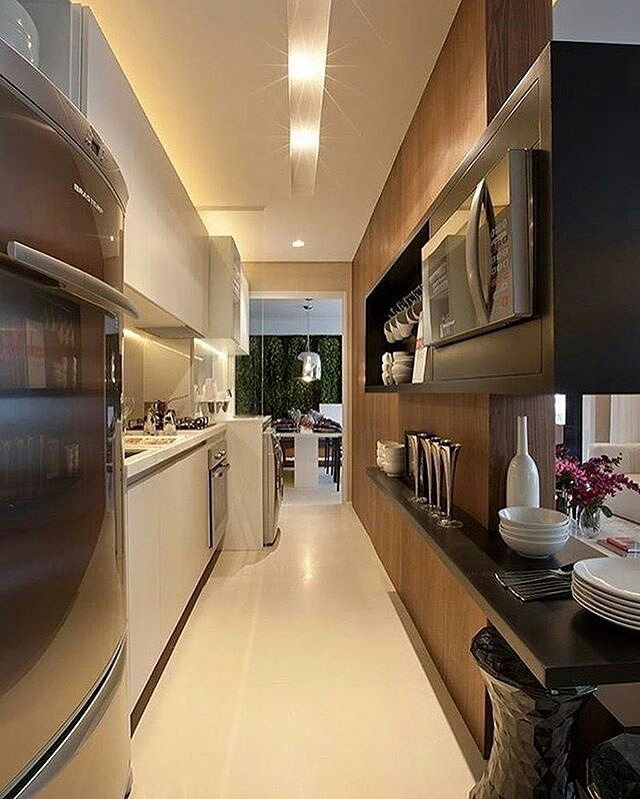 Furniture lighting will help you quickly find the right item and save you from having to turn on all the lights in the room.
Furniture lighting will help you quickly find the right item and save you from having to turn on all the lights in the room.
Photo: home-designing.com
9. No door
There is no need to close the door to your galley. There is not much space here, so there is no need to overload the room even more. As a last resort, install a sliding door or decorate the opening with beautiful textiles.
Photo: decorhint.com
10. Carpet on the floor
It may seem like such a small thing, but it can contribute to the effective arrangement of a galley in a narrow space. Lay a horizontal striped rug in the aisle - it will protect the floor from rubbing and visually push the walls apart.
Photo: home-designing.com
Kitchen design in galley style - compact and mega-practical - Articles - Small Spaces
Equip your kitchen in your apartment like on a cruise ship!
When planning a kitchen design, you often face the problem of how to place cabinets in the interior so that it is not only convenient, but also cozy.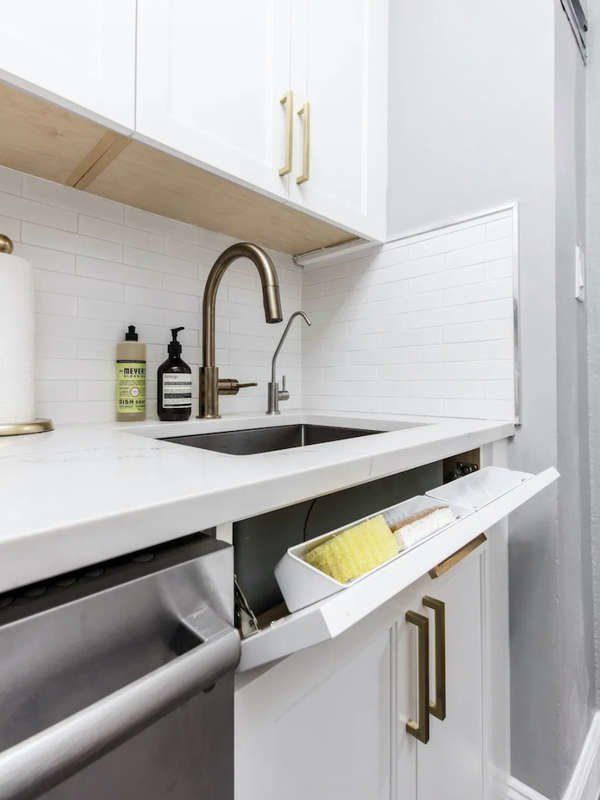 And no matter what size it is - large or small, narrow or wide - you want to place kitchen cabinets in such a way that, as they say, everything is at hand. We would like to suggest you one option, which, in our opinion, is ideal for any area. This is a galley style kitchen. Yes Yes. Exactly the same as on the ship.
And no matter what size it is - large or small, narrow or wide - you want to place kitchen cabinets in such a way that, as they say, everything is at hand. We would like to suggest you one option, which, in our opinion, is ideal for any area. This is a galley style kitchen. Yes Yes. Exactly the same as on the ship.
What is galley kitchen design?
According to Wikipedia, a galley is a space on a ship specially equipped for cooking. Simply put, a galley is a ship's kitchen. And since the premises on the ship most often have limited space, all the furniture for the kitchen at the cook (ship cook) was located on both sides - that is, it had a linear arrangement. This arrangement was very convenient, compact and practical.
The galley style on land has been adopted by professional chefs in restaurants and cafes, borrowing the idea of a linear layout for the kitchen from their marine counterparts. And if so, then why don't we use this idea and create something similar in our house?
And if so, then why don't we use this idea and create something similar in our house?
The galley style, as already mentioned, is perfect for kitchen interiors of any size. If your kitchen is wide and large, then a linear arrangement of cabinets will make the space more organized, efficient and clear. If it is narrow or small, it will visually expand it with the help of the right color scheme for cabinets and walls.
Well, how did you decide to try? Then see our ideas and get inspired!
Modern galley
Glossy sets are a great idea for a galley style kitchen. This modernized version of cabinets and bedside tables will create the illusion of spaciousness in a small kitchen space. The effect of gloss can be enhanced with spotlights. This method of reflective surfaces can be applied over large areas.
By removing “out of sight” all unnecessary things from the surfaces of cabinets, you will not only create a modern and minimalist kitchen interior, but also increase the space in this way.
Galley in open kitchens
Large kitchen spaces combined with living or dining rooms can just as easily be adapted to the style of the galley. The kitchen design in the photo above shows that the suite does not have to have a standard set of cabinets and cabinets. It can also be decorated as an island with a dining area. And all the rest that is needed for galley decoration is to stick to the parallel installation of headset cabinets.
Important details and simple tricks
Light furniture for the kitchen, the use of sets that do not have handles, wooden floors, glass doors, large windows ... All these details "work" for ease of movement and to expand the space in the interior kitchens.
Country & Rustic
The parallel galley layout is also perfect for rustic, country or farmhouse styles. Feel free to use all the elements and details of these rural styles in your kitchen design.